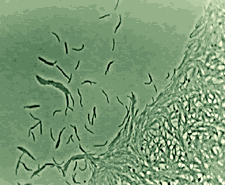| |
 |
Cellulose
is one of the most abundant biopolymers on earth. This common component
of plant cell walls is insoluble and relatively resistant to degradation. Cytophaga
hutchinsonii, an aerobic Gram-negative bacterium that is commonly
found in soil, rapidly digests crystalline cellulose (3). Molecular analysis
of cellulose degradation by C. hutchinsonii is now feasible, since techniques
for the genetic manipulation of this organism have recently been developed
(2). C. hutchinsonii belongs to the Cytophaga-Flavobacterium branch
of the eubacterial phylogenetic tree. Like many of the bacteria in this
group, C. hutchinsonii exhibits the ability to move rapidly over
surfaces by a process known as gliding motility. The mechanism of gliding
motility is not known, but flagella are not involved (1, 4). Gliding motility
is thought to be important in allowing C. hutchinsonii to colonize
its insoluble growth substrate. Analysis of the C. hutchinsonii genome
sequence will facilitate studies of cellulose degradation, which will be
important in developing new strategies to utilize this renewable resource.
It will also help to determine the mechanism of bacterial gliding motility,
which has remained an unsolved biological mystery for over 100 years.
|